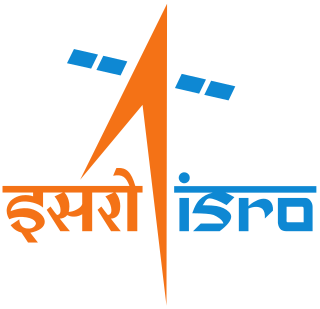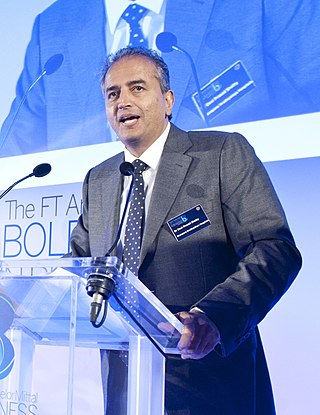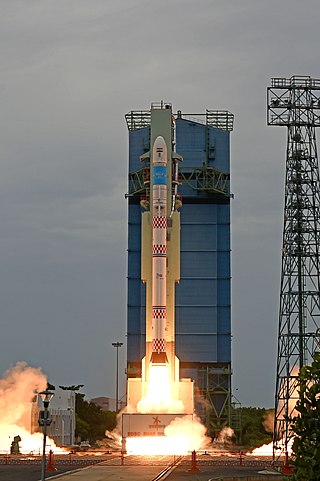Related Research Articles

The Indian Space Research Organisation is India's national space agency. It serves as the principal research and development arm of the Department of Space (DoS), overseen by the Prime Minister of India, with the Chairman of ISRO also serving as the chief executive of the DoS. It is primarily responsible for space-based operations, space exploration, international space cooperation and the development of related technologies. The agency maintains a constellation of imaging, communication and remote sensing satellites. It operates the GAGAN and IRNSS satellite navigation systems. It has sent three missions to the Moon and one mission to Mars.

Devi Prasad Shetty is an Indian cardiac surgeon who is the chairman and founder of Narayana Health, a chain of 24 medical centers in India. He has performed more than 100,000 heart operations. In 2004 he was awarded the Padma Shri, the fourth highest civilian award, followed by the Padma Bhushan in 2012, the third highest civilian award by the Government of India for his contribution to the field of affordable healthcare.

The Indian Space Research Organisation (ISRO), over the years, has established a comprehensive global network of ground stations to provide Telemetry, Tracking and Command (TTC) support to satellite and launch vehicle missions. These facilities are grouped under ISRO Telemetry, Tracking and Command Network (ISTRAC) with its headquarters at Bangalore, India.

AstroSat is India's first dedicated multi-wavelength space telescope. It was launched on a PSLV-XL on 28 September 2015. With the success of this satellite, ISRO has proposed launching AstroSat-2 as a successor for AstroSat.

Indian Regional Navigation Satellite System (IRNSS), with an operational name of NavIC, is an autonomous regional satellite navigation system that provides accurate real-time positioning and timing services. It covers India and a region extending 1,500 km (930 mi) around it, with plans for further extension up to 3,000 km (1,900 mi). An extended service area lies between the primary service area and a rectangle area enclosed by the 30th parallel south to the 50th parallel north and the 30th meridian east to the 130th meridian east, 1,500–6,000 km (930–3,730 mi) beyond borders where some of the NavIC satellites are visible but the position is not always computable with assured accuracy. The system currently consists of a constellation of eight satellites, with two additional satellites on ground as stand-by.

Indian Institute of Space Science and Technology (IIST) is a government-aided institute and deemed university for the study and research of space science in Thiruvananthapuram, Kerala, India. IIST was set up in 2007 by the Indian Space Research Organisation (ISRO) under the Department of Space, Government of India. Indian Institute of Space Science and Technology Thiruvananthapuram is Asia's first space university.

Chandrayaan-2 is the second lunar exploration mission developed by the Indian Space Research Organisation (ISRO) after Chandrayaan-1. It consists of a lunar orbiter, the Vikram lunar lander, and the Pragyan rover, all of which were developed in India. The main scientific objective is to map and study the variations in lunar surface composition, as well as the location and abundance of lunar water.

Gaganyaan is an Indian crewed orbital spacecraft intended to be the formative spacecraft of the Indian Human Spaceflight Programme.

Do-it-yourself biology is a biotechnological social movement in which individuals, communities, and small organizations study biology and life science using the same methods as traditional research institutions. DIY biology is primarily undertaken by individuals with limited research training from academia or corporations, who then mentor and oversee other DIY biologists with little or no formal training. This may be done as a hobby, as a not-for-profit endeavor for community learning and open-science innovation, or for profit, to start a business.

K. Radhakrishnan a.k.a. Koppillil Radhakrishnan is an Indian space scientist who headed the Indian Space Research Organisation (ISRO) as Chairman of Space Commission, Secretary of the Department of Space, Government of India. Under his leadership, India became the first country to reach Mars in its first attempt.

Narayana Health is an Indian for-profit private hospital network headquartered in Bangalore. It was founded by Dr. Devi Shetty in the year 2000.

The NASA-ISRO Synthetic Aperture Radar (NISAR) mission is a joint project between NASA and ISRO to co-develop and launch a dual-frequency synthetic aperture radar on an Earth observation satellite in 2025. The satellite will be the first radar imaging satellite to use dual frequencies. It will be used for remote sensing, to observe and understand natural processes on Earth. For example, its left-facing instruments will study the Antarctic cryosphere. With a total cost estimated at US$1.5 billion, NISAR is likely to be the world's most expensive Earth-imaging satellite.

Hackteria is a web platform and collection on their wiki pages of open source biological art projects instigated in February 2009 by Andy Gracie, Marc Dusseiller and Yashas Shetty, after collaboration during the Interactivos?09 Garage Science at Medialab Prado in Madrid. According to their website the aim of the project is to develop a rich wiki-based web resource for people interested in or developing projects that involve bioart, open source software/open source hardware, DIY biology, art/science collaborations and electronic experimentation.

The Small Satellite Launch Vehicle (SSLV) is a small-lift launch vehicle developed by the Indian Space Research Organisation (ISRO) to deliver 500 kg (1,100 lb) payload to low Earth orbit or 300 kg (660 lb) payload to Sun-synchronous orbit. The rocket supports multi-orbital drop-offs capability for small satellites.
The Human Space Flight Centre (HSFC) is a body under the Indian Space Research Organisation (ISRO) to coordinate the Indian Human Spaceflight Programme. The agency will be responsible for implementation of the Gaganyaan project. The first crewed flight is planned for 2024 on a home-grown LVM3 rocket.

Bellatrix Aerospace is an Indian private aerospace manufacturer and small satellite manufacturing company, headquartered in Bangalore, Karnataka. The company was established in 2015 and in June 2022, the company raised $8 million in a Series A funding round to pursue the development of in-space propulsion systems.

The X-ray Polarimeter Satellite (XPoSat) is an Indian Space Research Organisation (ISRO)-manufactured space observatory to study polarisation of cosmic X-rays. It was launched on 1 January 2024 on a PSLV rocket, and it has an expected operational lifespan of at least five years.
The Center for Genomic Gastronomy is an independent research group that examines the biotechnology and biodiversity of human food systems. The Center was founded in 2010 in Portland, Oregon and currently has research nodes in Bergen; Santa Cruz, CA; Porto; Dublin and Chennai. They are sometimes described as an artist-led think tank.

Radio Quarantine or Radio Quarantine Kolkata is an Indian internet-based community radio and podcast. It was founded on 25 March 2020 by a group of professors, directors and PhD students in response to social isolation protocols imposed as a result of the COVID-19 pandemic.
The Radio Quarantine was a Bangalore-based internet community radio launched on 26 March and operated by a network of independent composers and instrument makers.
References
- ↑ Nayar, Yimini (2 February 2018). "Raiders of the new art". Mint.
- ↑ Glas, René (2019). The Playful Citizen: Civic Engagement in a Mediatized Culture. Amsterdam: Amsterdam University Press. p. 205. ISBN 978-94-6298-452-3.
- ↑ "Yashas Shetty 2018". Global Community Bio Summit. Retrieved 26 March 2020.
- ↑ "The Indian Sonic Research Organisation". TheISRO. Retrieved 26 March 2020.
- ↑ Kera, Denisa (8 June 2018). "Science Artisans and Open Science Hardware". Bulletin of Science, Technology & Society. 37 (2): 97–111. doi:10.1177/0270467618774978. S2CID 149789786.
- ↑ "Hackteria" . Retrieved 26 March 2020.
- ↑ Nayar, Yimini (2 February 2018). "Raiders of the new art". Mint.
- ↑ Krishnan, Remya; Manjaly-Antony, Lijo Anto; Dhar, Pawan K. (23 February 2011). "Building momentum for systems and synthetic biology in India". Systems and Synthetic Biology. 4 (4): 237–240. doi: 10.1007/s11693-011-9071-x . PMC 3065590 . PMID 22132049.
- ↑ Neurekar, Malavika (7 April 2020). "Radio Quarantine: Indian artists are trying to create a space for music and community in lockdown". Scroll.in . Retrieved 2021-01-04.